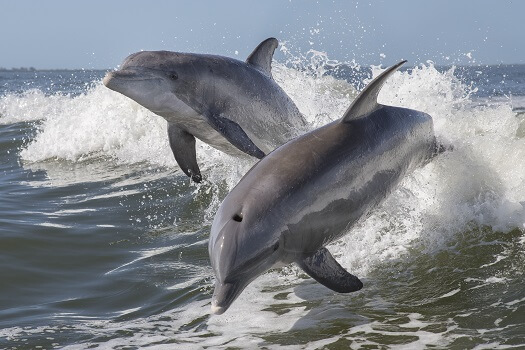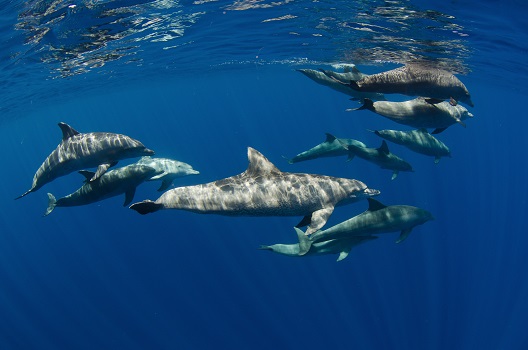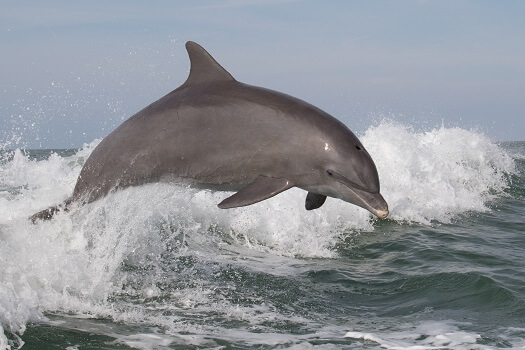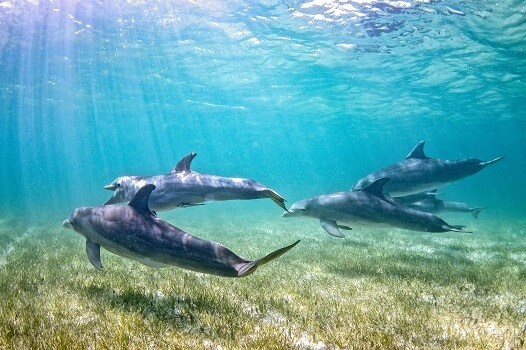
The bottlenose dolphin is a marine mammal belonging to the order Cetacea. There are two species; the common bottlenose, or Atlantic bottlenose dolphin (Tursiops truncatus), and the Indo-Pacific bottlenose dolphin (Tursiops aduncus). These species are the most commonly observed dolphins in the wild and are found in almost every sea and ocean, except for the colder waters of the North and South poles. Common bottlenose dolphins are relatively large, reaching up to 12.5 feet ( 4 m) in length and weighing up to 1400 pounds (640 kg). They can live for 40 – 60 years in the wild. These dolphins are mostly dark grey but they have a lighter belly. This type of coloration, called counter-shading, helps to conceal them from predators. Their body is extremely streamlined which helps them to move quickly through the water and they also have a short, blunt snout which is where they get the name ‘bottlenose’ from. Some bottlenose dolphins live in coastal areas while others are found in deeper water and spend their lives in the open ocean. Coastal populations are found in a wide range of habitats including seagrass beds, bays, estuaries, and beaches, and are more territorial than their oceanic counterparts. Oceanic populations, on the other hand, are migratory, moving from place to place. These dolphins can be found in small groups or pods of 2 – 15 animals, or in large groups that can have as many as 1,000 individuals. Oceanic populations are normally much larger than the coastal populations. Bottlenose dolphins eat a variety of food including several species of fish, squid, and shrimp, consuming between 13 and 15 pounds ( 6 – 7 kg) of food a day! They are extremely intelligent and will often hunt in pods, encircling large schools of fish and taking turns to swim into the middle to eat. They also have two stomachs! One stomach is used to store food while the other digests it. Bottlenose dolphins are also very social and playful animals. They have been shown to form friendships that last decades. They will often be found surfing in the waves and wakes of boats as well as swimming through self-made bubble rings. These dolphins reach sexual maturity between 5 and 14 years of age and some individuals are known to breed for their entire life, which is fairly rare amongst mammals. Like the majority of mammals, females give birth to live young after a 12-month gestation period. One calf is born every 3 to 6 years. The young are born tail first and can swim from the moment they are born. However, they are dependant on their mothers for much longer, with some mothers nursing their young for up to two years. The common bottlenose dolphin is the most commonly-held species of cetacean in captivity and hundreds are held in zoos and marine parks around the world. The conditions in these captive environments are a far cry from their natural habitat, offering very little in the way of mental stimulation. Fortunately, some people have started to recognize the detrimental effects that captivity has on these animals and many countries are phasing out the capture and retention of these animals for entertainment. Their main threats in the wild come from sharks and humans. Sharks are known to attack bottlenose dolphins and will try to take the juveniles as prey if they can. Humans pose a greater threat, as bottlenose dolphins can accidentally become entangled in fishing gear which can result in their death. Pollution in the water, as a result of agricultural runoff, can also cause problems, especially for juvenile dolphins that receive high levels of contaminants in their mother’s milk. Pollution can also result in algal blooms which have been linked to dolphin deaths in coastal regions. Bottlenose dolphins are the most famous of the dolphin species. These social animals are highly intelligent and quick learners. They have demonstrated the ability to solve problems, have self-awareness, and show feelings such as joy and grief. These amazing animals can be found in coastal regions, as well as out at sea, and have several biological adaptations that make them suited for their environment. Let’s take a closer look! One quirky adaptation that bottlenose dolphins use is called porpoising. This is when dolphins swim so fast that they come up through the surface of the water, emerging briefly before they go back down again. Bottlenose dolphins tend to use this move several times in a row. This singular, gliding motion isn’t used by the dolphins just for fun, it actually enables them to conserve energy while swimming fast! Quite a few animals swim using this wave-like motion and there is the belief that it not only conserves energy but can be used to confuse predators. Some animals that can be found porpoising include penguins, sea otters, auks, and other seabirds. Dolphins are some of the fastest and agile swimmers in the animal kingdom. Bottlenose dolphins are known to reach speeds over 18 mph and they can leap up to 20 feet out of the water. This adaptation helps them to effectively escape from predators and is also a useful hunting skill. How dolphins reach such speeds was a question that puzzled researchers for a long time but recent studies have shown that their power is all in their tail! A dolphin’s tail, known as a fluke, is very muscular and provides enough thrust to power a dolphin through the water at amazing speeds. Dolphins aren’t the only animal that use their tails to help them move quickly. Crocodiles also have a strong, muscular tail that helps to propel them quickly through the water. Crocodiles can actually move faster than dolphins, reaching speeds of up to 20 mph! Dolphins rely on sound to navigate their way around their ocean habitat and to communicate, hunt and avoid predators. Scientists have discovered that bottlenose dolphins can identify themselves with a signature whistle. The dolphins can use these signature whistles to identify themselves to other dolphins, sometimes over long distances so that they can be located. It is also thought they use these whistles in social interactions. A mother dolphin will also use this whistle to help her calf identify her. After birth, the mother may whistle to her calf for several days so that it learns to recognize its mother’s call. The calf develops its own unique whistle soon after birth, with some developing it when they are just one month old! Dolphins also use sound to echolocate. The dolphins project high-frequency sound waves, produced by making clicking sounds, and listen for the echos. They can then interpret this echo to locate an object or prey item. Sound waves travel much faster through water than they do through air, making this an effective location tool. The sequences of clicks that the dolphin produces pass through the melon – a key organ that is found in their forehead and is formed from adipose tissue. This organ focuses and modulates these outgoing sound waves. The sound waves are projected like a beam in the water in front of the animal. These sound waves then bounce off of the first object that they reach and return to the dolphin as an echo which can then be interpreted. Echolocation can inform the dolphin of the size, shape, speed, distance, and location of the object the sound bounces off. Bats, shrews, and other species belonging to the dolphin and whale families use echolocation to navigate. The best echolocation abilities belong to the narwhal, thanks to its distinctive horn. While dolphins often use echolocation to hunt for prey, they also have amazing eyesight. Their eyes are located laterally, with one on either side of their head, which enables them to get a good view to the front, back, and to the side of their body. Their eyes are capable of functioning independently which enables them to keep an eye on their environment in all directions simultaneously. The lenses in a dolphin’s eye are also able to change shape, depending on whether they are above or under the water. This means that they can see almost as well when their heads are above the surface as they see under it. Bottlenose dolphins are also extremely sensitive to blue light. This means that they have great vision at depth and in low-light conditions, helping them to see their prey when they dive to deeper depths. Dolphins do however lack the cones that enable color vision in other animals, so it is like that they are color blind.
Kingdom
Animalia
Phylum
Chordata
Class
Mammalia
Order
Cetacea
Family
Delphinidae
Genus
Tursiops
Species
Tursiops truncatus and Tursiops aduncus
Length
10 – 12.5 feet ( 3 – 3.8 meters)
Weight
Up to 1.400 feet (640 kg)
Lifespan
45 – 50
Social Structure
Social, live in large pods
Status
Least Concern
Habitat
Tropica oceans and other warm waters
Average litter size
1
Main food item
Fish, squid, crustaceans
Main predators
Humans and Sharks
The Basics

Threats to Bottlenose Dolphins
Fun Facts about the Bottlenose Dolphin!
Porpoising

The Bottlenose Dolphins is an Excellent Swimmer!
Communication and Echolocation
A Unique Whistle
Echolocation

Amazing Eyesight
